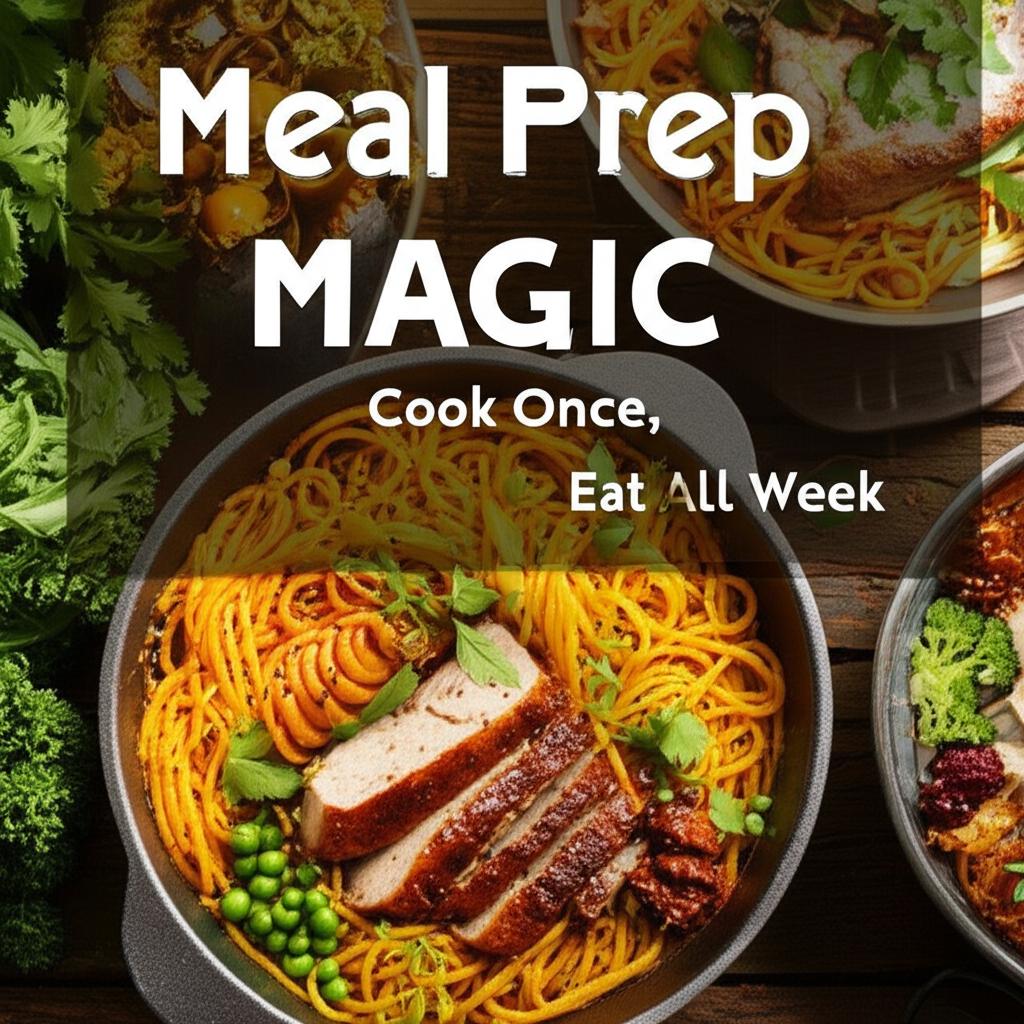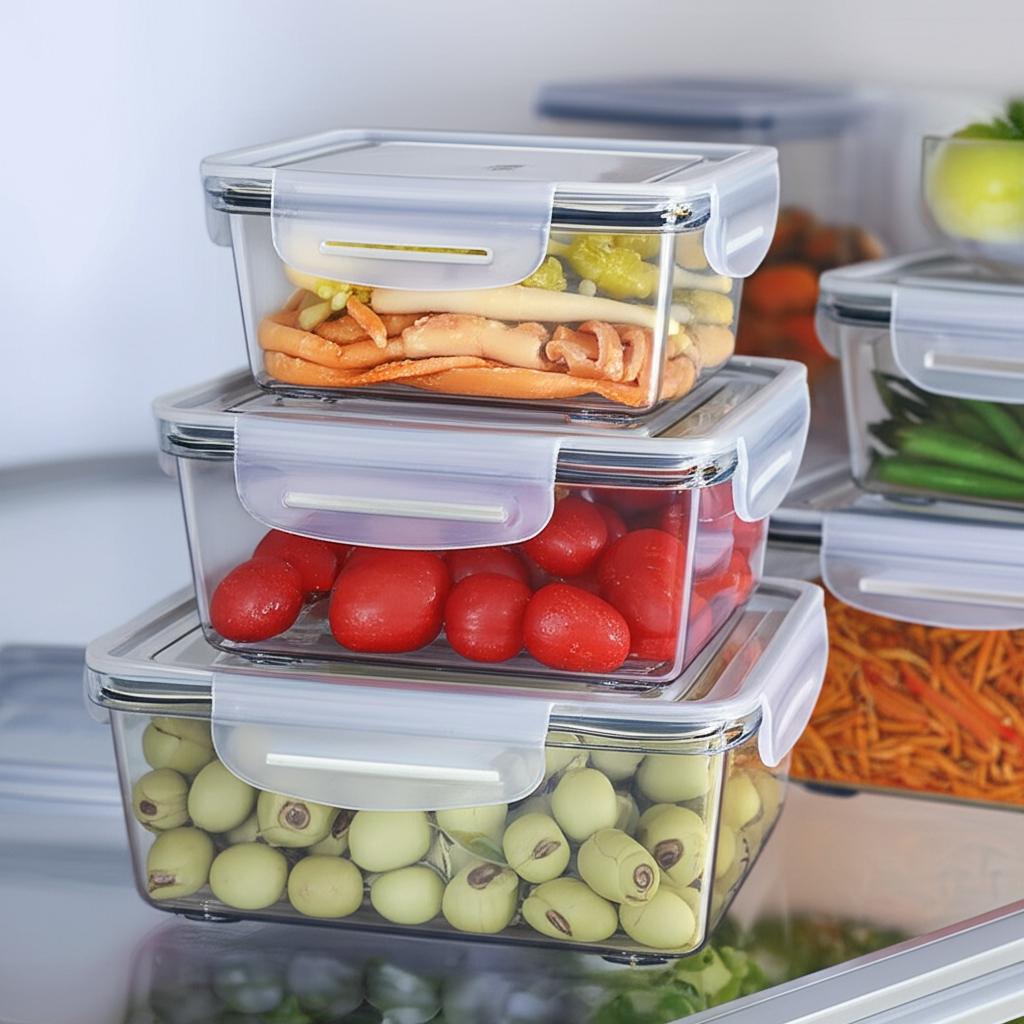
Meal Prep Magic: Cook Once, Eat All Week – Unlock Health, Time, and Flavor with Smart Batch Cooking
Imagine this: It’s Tuesday evening. You’ve just walked in the door after a long day. Instead of facing the dreaded “What’s for dinner?” dilemma, rifling through the fridge for sad-looking ingredients, or reaching for your phone to order expensive takeout, you simply open a perfectly portioned container, heat, and enjoy a delicious, wholesome meal. Sound like a dream? It’s not. It’s the everyday reality for those who have discovered the transformative power of meal prepping.
Meal prepping, or “batch cooking,” is more than just a trend; it’s a strategic culinary practice that allows you to cook a significant amount of food in one dedicated session, designed to be enjoyed over the course of the week. It’s about leveraging your time in the kitchen so you can spend less time cooking later and more time living.
Why Embrace Meal Prep Magic? The Irresistible Benefits
The “magic” of meal prep isn’t just about convenience; it cascades into numerous aspects of your life:
- Reclaim Your Evenings: Free up precious weekday hours typically spent cooking, cleaning, and stressing. Instead, you can exercise, pursue hobbies, spend time with loved ones, or simply relax.
- Eat Healthier, Effortlessly: When healthy options are readily available, you’re less likely to succumb to unhealthy impulse buys or drive-thru temptations. Meal prep empowers you to control ingredients, portion sizes, and nutritional content.
- Save Serious Money: Dining out and ordering takeout add up quickly. By buying ingredients in bulk, minimizing food waste, and cooking at home, you’ll see a significant reduction in your grocery and food budget.
- Reduce Food Waste: Planned meals mean you buy exactly what you need and use up ingredients efficiently, leading to less spoiled food in your fridge.
- Minimize Decision Fatigue: The daily grind of deciding what to eat can be draining. With meals prepped, that mental burden is lifted, freeing up your cognitive energy for more important things.
- Learn and Grow as a Cook: Regular meal prepping encourages you to experiment with new recipes, refine your culinary skills, and understand ingredient synergy.
The “Magic” Revealed: How Meal Prep Works
At its core, meal prepping involves three main phases: Planning, Prepping, and Enjoying.
Phase 1: The Planning Stage (Typically Weekend or Off Day)
This is where the real magic begins. Dedicate 30-60 minutes to this step.
- Assess Your Week: Look at your upcoming schedule. Are there any late nights, early mornings, or special events that will impact your eating habits?
- Choose Your Meals:
- Start Simple: If you’re new, pick 2-3 dishes you love that lend themselves well to batch cooking (e.g., a hearty soup, roasted chicken with veggies, a grain bowl base).
- Consider Variety: To avoid boredom, think about how you can use core ingredients in different ways (e.g., roasted chicken can become part of a salad, a wrap, or a grain bowl).
- Balance Macros: Aim for a good mix of protein, complex carbohydrates, and healthy fats.
- Don’t Forget Breakfasts & Snacks: Overnight oats, hard-boiled eggs, or chopped fruit can be prepped too.
- Check Your Inventory: See what ingredients you already have on hand to avoid duplicate purchases.
- Create Your Shopping List: Be specific! List exact quantities. Organize your list by supermarket aisle to save time.
- Clean Your Kitchen: A tidy workspace makes the prep day much smoother.
Phase 2: The Prep Day (Your Dedicated Cooking Session)
This is where the bulk of the work happens. Set aside 2-4 hours, put on some music or a podcast, and get ready to cook!
- Gather Your Tools: Make sure you have all your cutting boards, sharp knives, sheet pans, large pots, and most importantly, your meal prep containers ready.
- Wash and Prep All Produce: Wash and dry all fruits and vegetables. Chop, dice, and slice everything needed for the week. Store pre-chopped veggies in airtight containers.
- Cook Core Components:
- Proteins: Roast a large chicken, bake a batch of chicken breasts or thighs, cook ground meat, boil eggs, bake tofu, or cook a big pot of lentils/beans.
- Grains: Cook a large batch of quinoa, brown rice, farro, or couscous.
- Vegetables: Roast a medley of root vegetables (carrots, sweet potatoes, broccoli), steam green beans, or sauté a large pan of greens.
- Assemble or Store Components:
- Full Meals: For dishes that hold up well (soups, stews, chili, casseroles), portion them directly into individual containers.
- Components: For mix-and-match meals, store cooked proteins, grains, and veggies separately in airtight containers. This allows for greater flexibility and prevents sogginess.
- Cool Completely: Crucial Step! Allow all hot food to cool down to room temperature before covering and refrigerating. This prevents bacterial growth and keeps food safer.
- Label and Date: Use masking tape and a marker to label containers with the meal and date of preparation. This helps you keep track and ensures food safety.
Phase 3: Enjoyment All Week Long
This is where your investment pays off! Grab a container, heat it up, and savor your delicious, homemade meal. Add fresh elements like avocado, fresh herbs, or a squeeze of lime juice for extra flavor and texture when serving.
Essential Tools for Your Meal Prep Journey
You don’t need a gourmet kitchen, but a few key items will make your life easier:
- Airtight Containers: Glass is preferred for durability and ease of cleaning, but BPA-free plastic works too. Look for stackable, microwave-safe options.
- Sharp Chef’s Knife & Cutting Boards: Efficiency in chopping saves immense time.
- Large Roasting Pans/Sheet Pans: For batch roasting vegetables and proteins.
- Large Stock Pot & Skillet: For grains, soups, and sautéing.
- Measuring Cups & Spoons: For accurate recipe following.
- Food Scale (Optional but helpful): For precise portion control.
Meal Prep Strategies & Ideas
Variety is the spice of life, especially in meal prepping. Here are popular approaches:
-
Batch Cooking Basics: Cook large quantities of foundational ingredients:
- Protein: Roasted chicken, ground turkey, baked salmon, hard-boiled eggs, lentils.
- Carbs: Quinoa, brown rice, sweet potatoes, pasta.
- Veggies: Roasted broccoli, bell peppers, carrots; steamed green beans; chopped salad greens.
-
Component-Based Prep: Cook separate components and mix-and-match throughout the week.
- Example: Roasted chicken + quinoa + roasted veggies one day; roasted chicken + salad greens + a fresh dressing another; quinoa + black beans + salsa for a meatless meal.
-
“One-Pot/One-Pan Wonders”: Dishes that cook entirely in one vessel are meal prep superstars.
- Chili, stews, curries, sheet pan dinners, casseroles, large frittatas. These are often easy to portion and reheat well.
-
Breakfast & Snack Prep: Don’t forget the most important meal!
- Overnight oats, yogurt parfaits, chia seed puddings, pre-portioned smoothie bags, energy bites, chopped fruit and veggie sticks with hummus.
Sample Meal Prep Week (Component-Based)
Let’s say on Sunday you prep:
A whole roasted chicken (shredded)
2 cups dry quinoa (makes ~6 cups cooked)
2 lbs mixed roasted vegetables (broccoli, bell peppers, zucchini)
A large batch of mixed greens (washed and dried)
Hard-boiled eggs
A simple vinaigrette dressing
Your Week Might Look Like This:
- Monday Lunch: Quinoa bowl with shredded chicken, roasted veggies, and a drizzle of dressing.
- Monday Dinner: Shredded chicken and roasted veggie wraps with whole wheat tortillas.
- Tuesday Lunch: Large salad with mixed greens, shredded chicken, and sliced hard-boiled eggs.
- Tuesday Dinner: Leftover chili (prepped separately) with a side of quinoa.
- Wednesday Lunch: Quinoa and roasted veggie power bowl with chickpeas (add avocado when serving).
- Wednesday Dinner: Quick stir-fry using remaining chicken and fresh quick-cook veggies.
- Thursday Lunch: Repeat Monday Lunch or use up remaining components creatively.
- Throughout the week: Grab hard-boiled eggs or fruit for snacks.
Tips for Meal Prep Success
- Start Small: Don’t try to prep every single meal for the entire week on your first try. Begin with just lunches, or 3 dinners.
- Invest in Quality Containers: They are worth it for longevity, food safety, and aesthetic appeal.
- Vary Your Flavors: Even with the same base ingredients, different spices, herbs, and sauces can transform a meal.
- Don’t Forget Fresh Elements: Add crunch and freshness by incorporating fresh herbs, citrus wedges, or nuts just before serving.
- Label and Date Everything: It’s easy to forget what’s what and when it was made.
- Defrost Strategically: If freezing, remember to pull items from the freezer into the fridge the night before you plan to eat them.
- Embrace Flexibility: Life happens. If you don’t eat a prepped meal, don’t sweat it. You can often freeze it or adjust your plan.
Conclusion
Meal prep magic is a game-changer. It’s a powerful habit that transforms stress into calm, unhealthy choices into nutritious ones, and financial drain into smart savings. By dedicating a few hours each week, you unlock a week of effortless, delicious eating, giving you back precious time and peace of mind. So, grab your apron, plan your attack, and get ready to experience the freedom and flavor of cooking once and eating all week!
Meal Prep Magic: Effective FAQ Section
Q1: How long does prepped food typically last in the refrigerator?
A1: Most properly stored cooked meals and components will last 3-5 days in the refrigerator. This is why planning for about 4-5 days of meals is common. For anything beyond that, consider freezing portions.
Q2: What are the best types of containers for meal prepping?
A2: Glass containers with airtight lids are highly recommended. They are durable, safe for reheating in the microwave or oven (without lid), don’t stain or retain odors, and are easy to clean. BPA-free plastic containers are also a good, more affordable option, but may stain or retain smells over time. Look for containers with separate compartments if you like to keep components distinct.
Q3: How do I prevent my prepped meals from getting boring throughout the week?
A3: Variety is key!
* Component-based prepping: Cook base proteins, grains, and veggies, then combine them differently with various sauces, seasonings, and fresh additions (herbs, avocado, nuts) for distinct meals.
* Flavor Profiles: Use different spice blends (e.g., Mexican one day, Mediterranean the next) on the same core ingredients.
* Mix in fresh elements: Add fresh greens, a squeeze of lemon/lime, or a crunchy topping right before serving.
* Don’t prep every single meal: Leave room for one or two fresh cooks or a favorite takeout if you wish.
Q4: I’m new to meal prepping. Where should I start?
A4: Start small and simple. Don’t try to prep every meal for the whole week.
* Focus on one meal type: Try prepping just your lunches for the week, or 2-3 dinners.
* Choose familiar recipes: Pick dishes you already know and love that reheat well (e.g., chili, roasted chicken and veggies, a simple grain bowl).
* Master one batch cook: Try roasting a large batch of chicken or cooking a big pot of quinoa. Once comfortable, expand.
Q5: Can I freeze prepped meals, and which ones freeze best?
A5: Yes, many prepped meals freeze wonderfully! This is great for extending shelf life beyond 5 days.
* Excellent for Freezing: Soups, stews, chilis, casseroles, cooked grains (rice, quinoa), cooked ground meats, shredded chicken, and many baked goods (muffins, energy bites).
* Less Ideal for Freezing: Dishes with high water content vegetables (like lettuce, cucumbers, or raw tomatoes), creamy sauces (can separate), and delicate seafood.
* How to Freeze: Ensure food is completely cool before freezing in airtight, freezer-safe containers or bags. Label clearly with the dish and date. Thaw overnight in the refrigerator before reheating.

